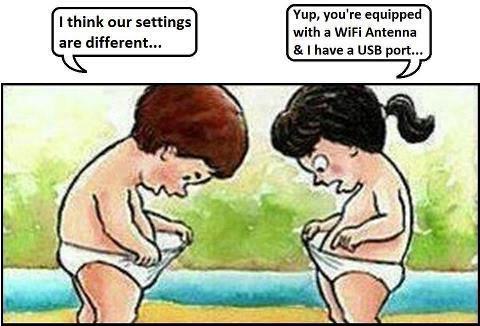The most interesting and lively conversations I had about gender stereotypes and gender differences are definetly the ones with men and women whose way of thinking was practically opposite to mine. I am re-posting a comment to one of my reader here as my conversation with this reader has reminded me of all my past assumptions and believes about gender and it is somewhat amusing for me to see how my position regarding these issues has changed so drastically throughout the years.
The last twenty years of neuro-scientific research have highly disproved that there is actually much difference between male and female in term of how our brains are wired from birth. Lise Eliot (Pink Brain, Blue Brain) made a powerful example of this in her comparison of graphs (see page 12) regarding psychological /attitudinal gender differences compared to physical gender difference such height. While the difference in height is significant and cannot be denied, the difference in psychological and attitudinal characteristics are remarkably minimal and their distribution tend to overlap at all points of the curves: this means you can probably predict with reasonable degree of confidence on the basis on gender that a man will be taller than a woman, but in terms of psychological and attitudinal characteristics we cannot predict with confidence any of them on the basis of gender.
But what has been discovered by neuro-scientists in hundred and hundred of studies is something even more significant: it’s called ‘neuro-plasticity’. It means that while in previous years scientists thought that our brain characteristic (or ‘wiring’) was somehow fixed, now it is evident that the brain (its neurons and all its nervous pathways and connections, so-called ‘wiring’) develops and grows in response to the enviroinment, with the creation of new neurons and new pathways depending on the activities that we do, our thoughts, emotions, habits in response to our enviroinment. This means that our education, the messages we get from parents and society, the toys we play with and all other enviroinmental influences will mold and shape our brain from the day we born. This is why the brain differences between the two sexes are incredibly minimal at birth, to become something noticeable once adulthood is reached.
The trouble is GENDER DIFFERENCES ARE SEXY (to borrow again from Lise Eliot). How boring would be to think that we are not this explosive encounter and exciting clash of ‘Mars and Venus’? Our brain is naturally inclined to form categories and opposites. We love dichotomies and contrasts. Media and marketing thrive on this desire of men and women to be different, like being from different planets (see the incredible success of the 1992′s book “Men are from Mars and Women are from Venus” of John Gray – which conclusions are much more based on what people experience, feel and see in their relatioships and every day life, rather than on solid scientific evidences). After all, the marketing of any product is based on something called ‘segmentation’… dividing a big mass of consumers into well defined categories and niches of people with similar characteristics (in this sense, marketers LOVE stereotypes!). To be honest I was one of the most firmly convinced individual about gender differences until just a few years ago (funnily enough). Coming from Italy, I’ve been brought up in a society and culture with strong patriarchal values, further reinforced by a even stronger religious values based on Catholicism. Naturally then, I’ve always been tempted to believe in BIG, undeniable, innate differences between men and women’s psychology: afterall, this was my direct experience of relatioships with most boys and men in my life! (How can someone ever deny such an obvious difference I thought? How can someone deny my own experience of things?)
But when I DID stop and look at the real scientific evidence out there, I had to question my believes and I gradually started to appreciate the differences between men and women (/boys and girls) as something which is acquired and grow through many years of “molding” our brain and behaviour under social and enviroinmental expectations. Reflecting on how we become like we are is a fascinating phenomenon and I know these discoveries are positive in terms of making girls and boys (the women and men of tomorrow) much more close and similar than what has been in the past.
THIS WILL BRING MORE UNDERSTANDING AND LESS POLARISATION. It will also bring more freedom for each individual to grow their feminine and masculine sides at their own leisure (all the more so as scientist have also proved that individuals with a good mix of masculine and feminine attributes/attitudes – so-called androgynous – are generally advantaged in both their social and emotional life). But this does not mean that the ‘sexiness of difference’ will disappear in our relationships (oh no! we don’t want that!), because that ‘sexy tension’ will always exist: it is between our individual characteristics, feminine or masculines or a mix of them. So that a masculine type (either men or woman) will be always attracted by a feminine type (either man or woman) and a feminine type will be always attracted by a masculine type: so that, in truth, to beat gender stereotypes is only to leave every boy and girl (alas every man and woman) free to follow their natural inclinations towards femininity/masculinity and express their individuality without ‘gender molding’ constantly applied to them.
I am also convinced that the emphasis should not be so much on censorship, or an array of strict regulations and limitations applied to businesses, marketing and media productions (with exceptions of course, as I would gladly see Photoshop manipulations disappear from advertising practice) : after all, the profit interests at the basis of the system would make very unlikely a drastic change of direction, at least in the immediate future. I propose that the emphasis should be much more on making young girls and boys more critical towards media and marketing messages: by changing the way our boys and girls react to the environment we will allow them to be sophisticated and independent consumers, who will be able to shape the economic and ideological fabric of tomorrow ‘s world through their informed demand or rejection for certain products /media /marketing practices, their patterns of consumption. In other words, by educating children on concepts such as ‘gender stereotypes’, ‘objectification’, ‘sexism’ or ‘sexualisation’ we will be able to eventually affect the system from the inside out.
Additional reading:
http://www.dailymail.co.uk/sciencetech/article-2273972/Men-Mars-Women-Venus-Actually-planet.html


